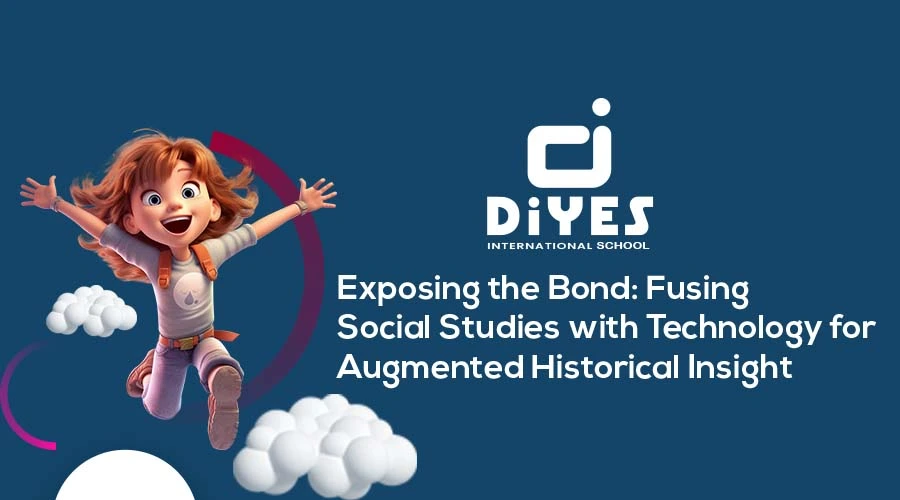The evolution of education has witnessed a paradigm shift with the integration of technology in Social Studies. This transformative fusion goes beyond conventional teaching methods, offering students an immersive and participatory experience in understanding historical, geographical, and sociological concepts. From interactive whiteboards to virtual reality, this blog explores the dynamic relationship between Social Studies and Technology, highlighting the significance of each facet and the synergies they create.

This blog delves into the revolutionary integration of Social Studies and Technology, marking a departure from traditional educational paradigms. It examines the significance of this fusion in bringing history to life through immersive experiences, embracing interactive learning platforms, and overcoming obstacles in the process. Each section explores how technology reshapes education, nurturing a more dynamic, engaging, and globally connected learning experience.
Decoding the Essence: A Revolution in Educational Perspectives
Social Studies, encompassing disciplines such as history, geography, sociology, and more, stands as the cornerstone of a comprehensive education. Traditionally, the conveyance of Social Studies knowledge has relied on conventional methods, predominantly textbooks and lectures. However, the contemporary educational landscape is witnessing a revolutionary transformation through the seamless integration of technology. This integration represents a profound departure from the age-old model of passive knowledge consumption, propelling students into the realm of active participation and immersive learning experiences.
In the traditional paradigm, students were often relegated to the role of passive recipients, absorbing information from textbooks and lectures without active engagement. The integration of technology, in its multifaceted forms, has shattered this conventional mould. Students are no longer confined to absorbing facts; they are now active participants in their educational journey. This shift holds immense significance as it transcends the boundaries of rote memorization, ushering in an era where learning becomes dynamic, engaging, and participatory.
The departure from rote memorization is a pivotal aspect of this transformation. In the traditional approach, students were often tasked with memorizing historical dates, geographical facts, and sociological theories without a true understanding of the context or relevance. The integration of technology dismantles this rote learning model. Instead of memorizing facts in isolation, students are now encouraged to actively explore, analyze, and apply their knowledge in meaningful ways.
The participatory learning experience facilitated by technology is a game-changer. Students are no longer confined to the passive absorption of information; they become explorers, investigators, and contributors to their own learning journey. Interactive tools, multimedia resources, and collaborative platforms empower students to actively delve into the depths of Social Studies. Whether through virtual field trips, interactive simulations, or collaborative projects, students now have the tools to be architects of their educational experience.
This shift from passive to active participation also aligns with contemporary educational philosophies that emphasize student-centered learning. Instead of being mere consumers of information, students, through technology integration, become co-creators of knowledge. This not only deepens their understanding of Social Studies concepts but also nurtures critical thinking, analytical skills, and a genuine passion for exploration.
In essence, the significance of integrating technology into Social Studies lies in the transformative power it wields over the educational experience. It heralds a departure from the traditional, often monotonous, methods of teaching and learning. By nurturing lively participation, encouraging critical analysis, and promoting interactive exploration, this fusion not only amplifies comprehension of historical, geographical, and sociological concepts but also provides students with the abilities and perspective essential for excelling in a constantly changing world. It is a paradigm shift that empowers students to not only absorb knowledge but actively shape and contribute to the rich tapestry of Social Studies education.
The Evolution of Education: Embracing Technological Metamorphosis
The landscape of education, once dominated by the timeless duo of chalkboards and textbooks, has undergone a profound metamorphosis with the advent of technology. This transformative journey has ushered in an era where traditional teaching methods are no longer the sole architects of learning. Interactive whiteboards, educational apps, and a plethora of online resources have seamlessly woven themselves into the fabric of education, reshaping the classroom experience and providing students with a diverse toolkit to engage with knowledge. This evolution not only marks a departure from conventional practices but also heralds a new age of dynamic and interactive learning.
- The Rise of Interactive Whiteboards:
One of the most noticeable facets of this educational evolution is the ascent of interactive whiteboards. These digital successors to traditional chalkboards are interactive displays that respond to touch, allowing educators to engage students in a more dynamic and visually immersive manner.

The static nature of traditional chalkboards has given way to a canvas of endless possibilities. Concepts in history, geography, and sociology can now be brought to life with vivid visuals, nurturing a deeper understanding of abstract ideas through interactive engagement.
- Educational Apps:
In the era of smartphones and tablets, educational apps have become indispensable tools in the educational arsenal. These apps transcend the limitations of traditional textbooks by offering interactive and multimedia-rich content. Whether exploring historical events through virtual timelines, conducting virtual science experiments, or engaging in language learning through gamified apps, students now have access to a diverse range of resources tailored to their individual learning styles. This shift from one-size-fits-all to personalized, app-based learning experiences caters to the varied needs of students, nurturing a more inclusive and adaptive educational environment.
- Online Resources for Seamless Learning:
The integration of online resources has redefined the boundaries of the traditional classroom, extending learning beyond its physical confines. Virtual libraries, digital archives, and interactive websites provide students with a wealth of information at their fingertips. For Social Studies, this means access to primary source documents, virtual field trips to historical landmarks, and collaborative platforms for global discussions. The richness of historical narratives, the exploration of geographical wonders, and the understanding of societal structures are no longer confined to the pages of a textbook but are vividly accessible through the vast expanse of the digital realm.
- Dynamic and Interactive Learning:
The overarching theme of this educational evolution is the shift towards dynamic and interactive learning. Students are no longer passive recipients of information; they are active participants in their educational journey. The combination of interactive whiteboards, educational apps, and online resources empowers students to explore, question, and engage with academic content actively. This shift aligns with contemporary educational philosophies that emphasize experiential learning, critical thinking, and the development of real-world skills.
In conclusion, the evolution of education through technology signifies more than a change in tools; it represents a fundamental shift in the way knowledge is imparted and received. Interactive whiteboards, educational apps, and online resources are not mere additions to the classroom; they are catalysts for a more dynamic, engaging, and personalized learning experience. As we navigate this educational landscape shaped by technology, we find ourselves at the threshold of a new era—one where the fusion of traditional wisdom and technological innovation propels education into uncharted realms of possibility.
Bringing History to Life: Immersive Experiences Through Technology
Traditional approaches often struggle to make historical events resonate with students on a personal level. The challenge lies in transcending the pages of textbooks to offer a more engaging experience. Here, technology serves as a transformative force, converting historical learning into a vibrant and memorable journey.
Virtual Reality (VR) and Augmented Reality (AR): The integration of Virtual Reality (VR) and Augmented Reality (AR) technologies marks a paradigm shift in historical education.

These immersive technologies allow students to virtually step into historical settings, providing firsthand experiences that go beyond conventional teaching methods. This transformative shift in educational methodology empowers students to immerse themselves in historical narratives, breaking free from the constraints of traditional classroom settings.
Through the lens of Virtual Reality (VR) and Augmented Reality (AR), history comes alive as students traverse ancient landscapes, witness historical events unfold in real-time, and actively engage with the artifacts of bygone eras.
Furthermore, technology in Social Studies not only enhances the understanding of historical contexts but also encourages collaborative learning experiences. Students can embark on virtual field trips, collaborating with peers to solve historical puzzles, analyze primary sources, and simulate historical scenarios. This collaborative aspect nurtures a sense of shared discovery and cultivates valuable teamwork and communication skills.
The integration of VR and AR technologies in Social Studies heralds a new era in historical education, where students are no longer passive observers but active participants in their own learning journey. As we embrace these immersive technologies, the boundaries between the past and the present blur, creating a rich and dynamic educational landscape that resonates with the digital-native generation.
Overcoming Obstacles: Navigating Challenges in Integration
Integrating Social Studies and Technology presents exciting opportunities but also demands addressing key challenges for a successful fusion of these educational pillars.
- Access to Technology and Digital Literacy: Varying access to technology among students requires measures to bridge the digital divide. Schools should collaborate with community partners to ensure equitable access, accompanied by efforts to enhance digital literacy skills for responsible and critical technology use.
- Teacher Training and Professional Development: Proficiency in integrating technology into Social Studies lessons is crucial. Comprehensive teacher training programs and continuous professional development empower educators to effectively leverage technology, transforming classrooms into dynamic learning environments.
- Curriculum Alignment and Integration Strategies: Harmonious alignment between Social Studies curricula and technology integration is vital. Collaborative efforts among educators, curriculum developers, and technology specialists are needed to develop guidelines that incorporate technological tools and resources. Effective integration strategies catering to diverse learning styles should also be implemented.
- Digital Equity and Inclusivity: Prioritizing digital equity and inclusivity ensures that all students benefit equally from technological enhancements. Inclusive practices, such as providing multilingual resources and culturally relevant content, create a learning environment that resonates with a diverse student population.
- Assessment and Evaluation in the Digital Age: The shift to a technologically integrated approach requires a re-evaluation of assessment methods. Schools should explore innovative tools like digital portfolios and online quizzes, adapting evaluation mechanisms continually to capture the skills and knowledge acquired through technology-mediated learning.
Navigating challenges in the integration of Social Studies and Technology is a transformative journey that demands strategic planning, ongoing support, and a commitment to digital equity. Proactively addressing these obstacles unlocks the full potential of this synergy, providing students with a comprehensive and future-ready education.
Conclusion: A Nexus of Learning Unveiled
In essence, the fusion of Social Studies and Technology creates a powerful nexus, propelling historical education into an era of dynamic and immersive learning experiences. From breathing life into historical events through VR and AR technologies to embracing diverse learning styles, this integration redefines how students engage with the past. Interactive platforms, digital archives, and innovative pedagogical approaches contribute to a multifaceted approach that transcends traditional boundaries.
As we navigate this nexus of learning, it becomes evident that technology is not just a tool but a catalyst for transformation. The global connectivity facilitated by collaborative projects and virtual classrooms enriches students’ perspectives, nurturing a sense of global citizenship. Moreover, overcoming obstacles like access to technology and digital literacy is imperative for ensuring the inclusivity of these transformative practices.
In the dynamic landscape of educational innovation, DiYES International School stands as a beacon of proactive learning. Our commitment to shaping a supportive and engaging educational community aligns seamlessly with the ethos of integrating Social Studies and Technology.
To delve deeper into our approach to student success, we invite you to explore our website at www.diyesinternational.edu.in or connect with us directly at +91 8547609000. Engage with DiYES International School, where the nexus of Social Studies and Technology unfolds to enhance historical understanding, nurturing a community of proactive learners prepared for the challenges of the future.


